How To Build A Window Seat Bench
Jump to How-To
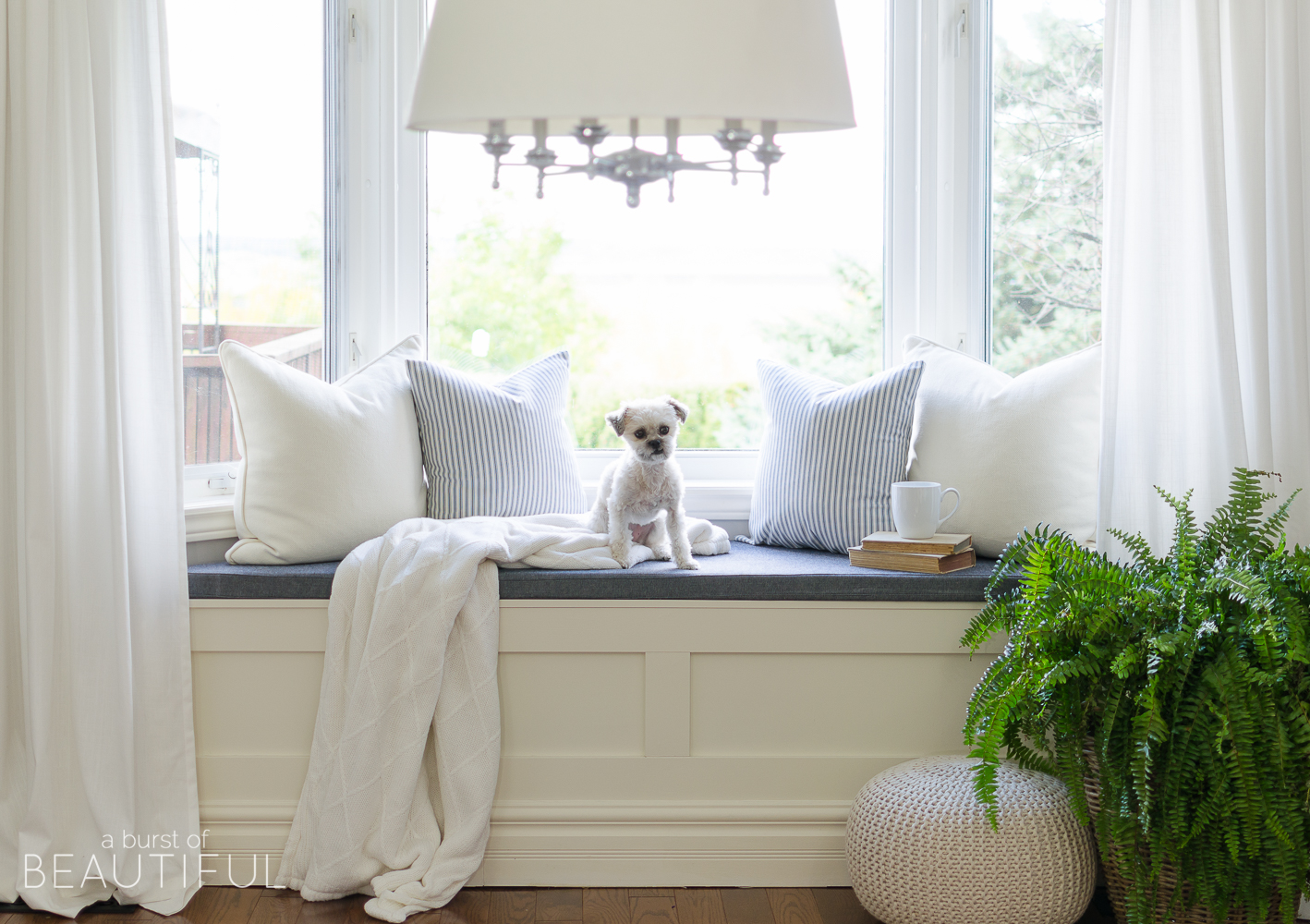
This little window bench is probably ane of our favorite projects we've completed in our house so far. I think back to when information technology was but useless, empty space and I can't believe we waited this long to employ information technology. Information technology truly was the perfect spot to add together a window demote and it adds such character and charm (non to mention extra storage space) to our dining room. Information technology'south the best spot in the house to curl up with a practiced volume and picket the world go past. And we'll show y'all how to build a window bench with storage in your own bay window beneath.
Alicia has always dreamed of having a window bench in our dwelling where she and Zoe can roll up and read stories. Somewhere out of the way, where Zoe's imagination tin run wild as the natural light bounces off the pages of her favorite books. How could I not oblige and turn our bay window into a cozy nook for the two of them?
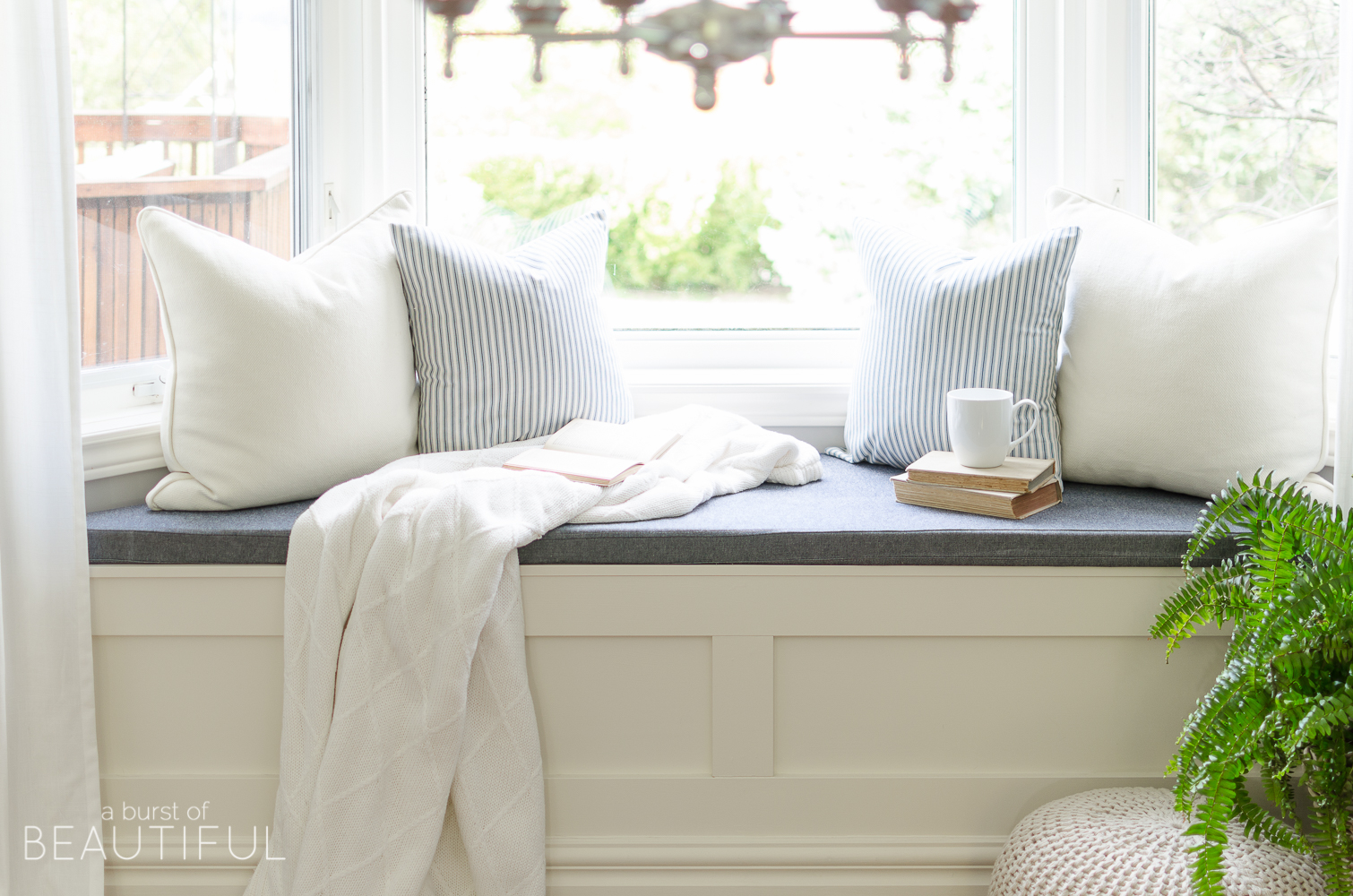
I don't spend much fourth dimension with my nose in a book, but it'southward not considering I don't like a well-written story. I just can't seem to stay awake long plenty to get through a full affiliate. Peradventure information technology'southward because I only have time to read before bed. But permit's confront it, we have a house, a toddler, and three pets to take intendance of so that's unremarkably the just time we have to read.
On the other hand, Alicia loves reading. She tin can go through a book each week (whereas I would accept virtually half-dozen months). Zoe loves to read books and has a few favorites, such as Where the Wild Things Are and I Love Yous Stinky Confront.
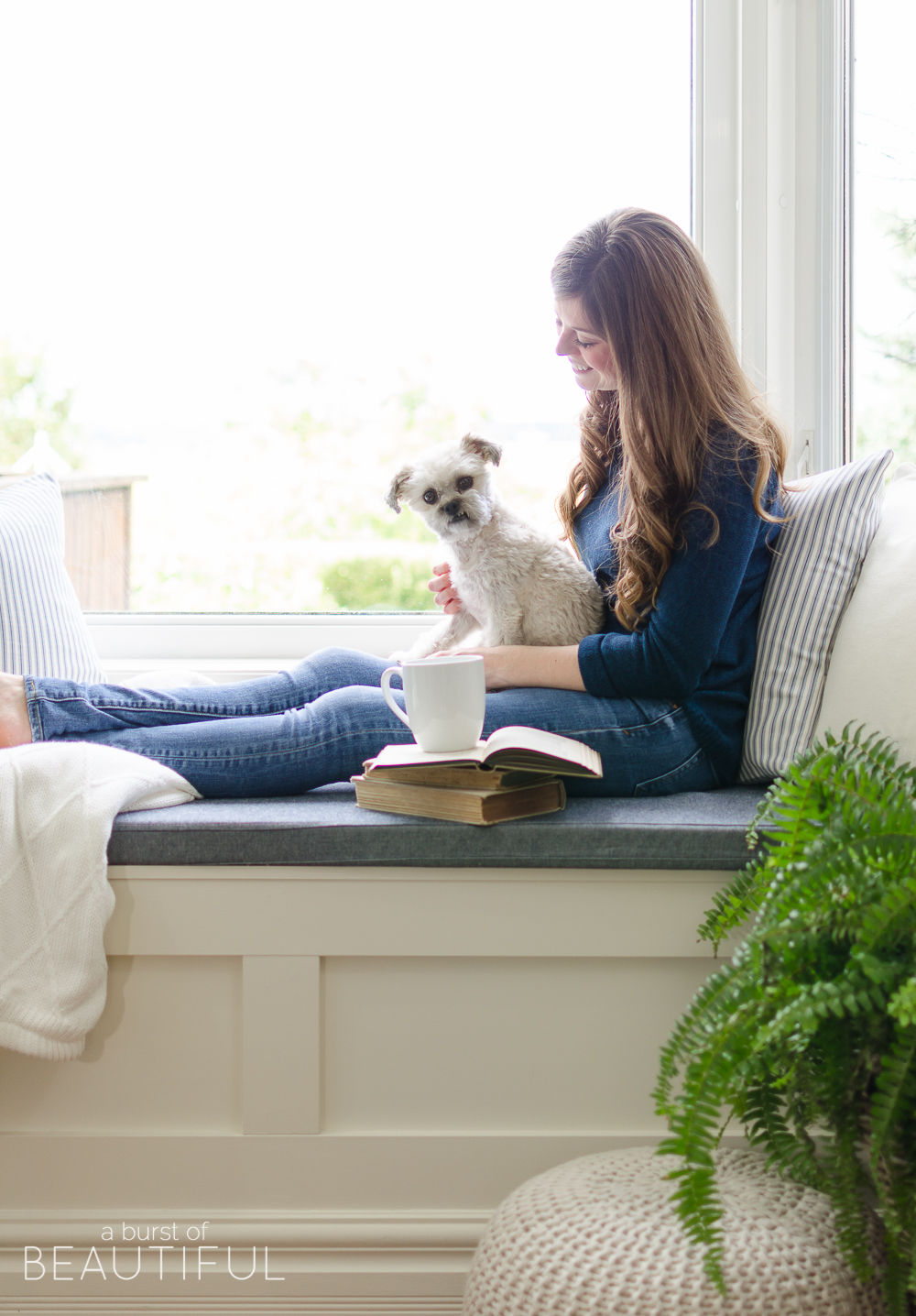
Our window overlooks the bay and faces West and then we have gorgeous sunsets that saturate the room at the terminate of each mean solar day. It is definitely God's manus that creates the art on that wall. Other than that, information technology is a pretty ordinary bay window, with not much else going for it. That's when we decided to brand information technology a focal betoken and useful space in the room.
Every bit I do with virtually of our projects, I sabbatum down to sketch out a plan. I commonly have a articulate vision in my head when I start a project, but I always need to sell it to Alicia who likes to see an epitome before I turn something into reality. It also helps me figure out what materials I demand and try to avoid whatever oversights that could happen due to poor planning.
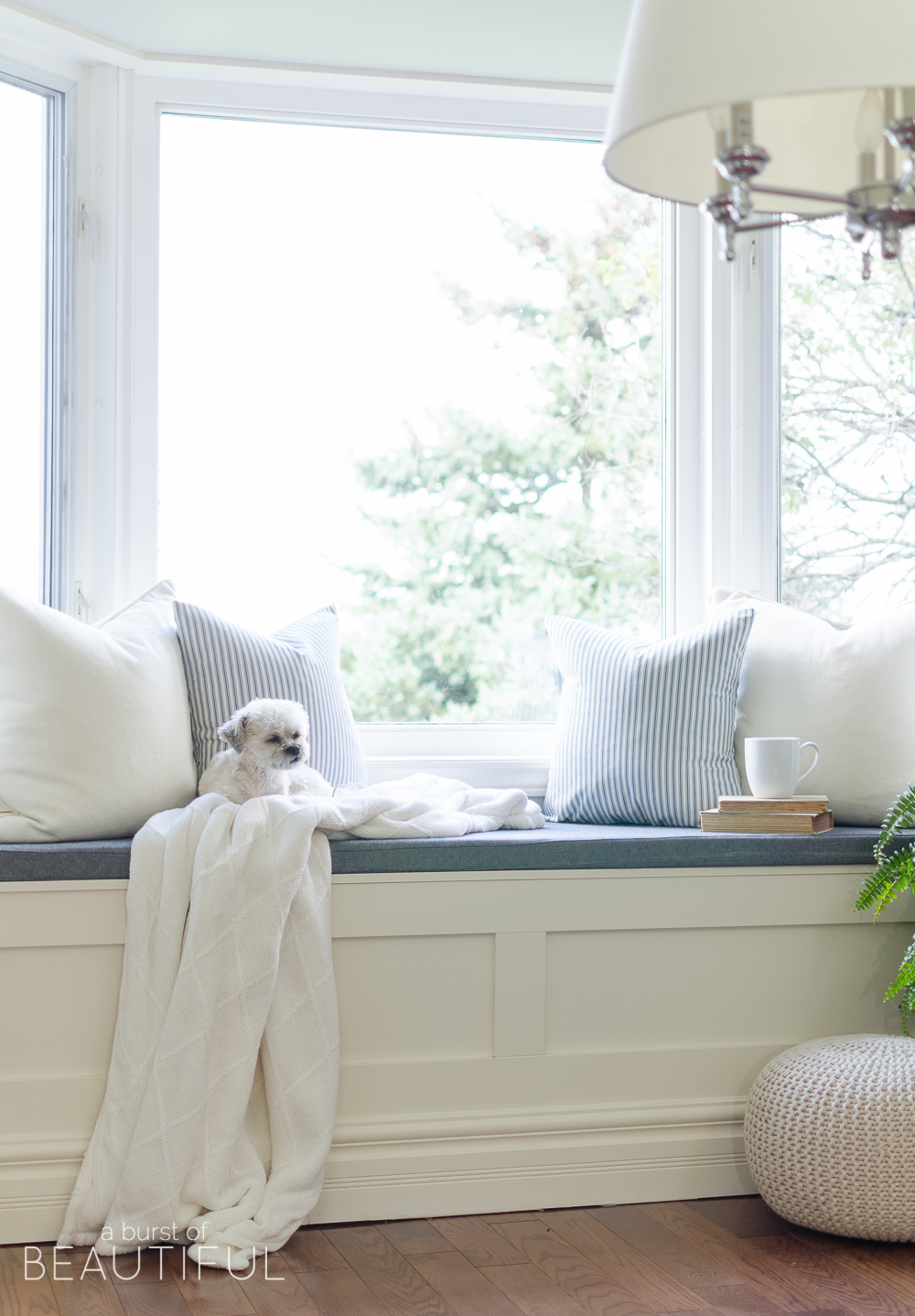
Our friends at The Habitation Depot loved the concept and wanted to work with us on this design. Information technology's a weekend projection that anyone with intermediate experience and the correct tools can tackle.
There are two ways y'all tin can build this bench: the easy way, or the harder manner. Aren't those always the options to choose from? Why can't information technology always be the easy way? I digress. The easy option is to build a sturdy frame and then cut a piece of plywood to size, add trim, fill holes, paint and yous're done. Easy, right?

The harder option is to build a demote with storage. At present, if your bay window is foursquare instead of angled, you'll have a much easier time. Ours is angled and if I had made the tiptop ane large slice, it wouldn't have lifted up due to the angles of the window. So I had to come upwardly with a blueprint where just the middle portion of the bench opened up. I as well wanted the lid to be hidden so that it would look seamless from the front once a cushion was placed on top, and it would as well keep our little i from being able to open it. This required a footling more than thought and proper pattern planning.
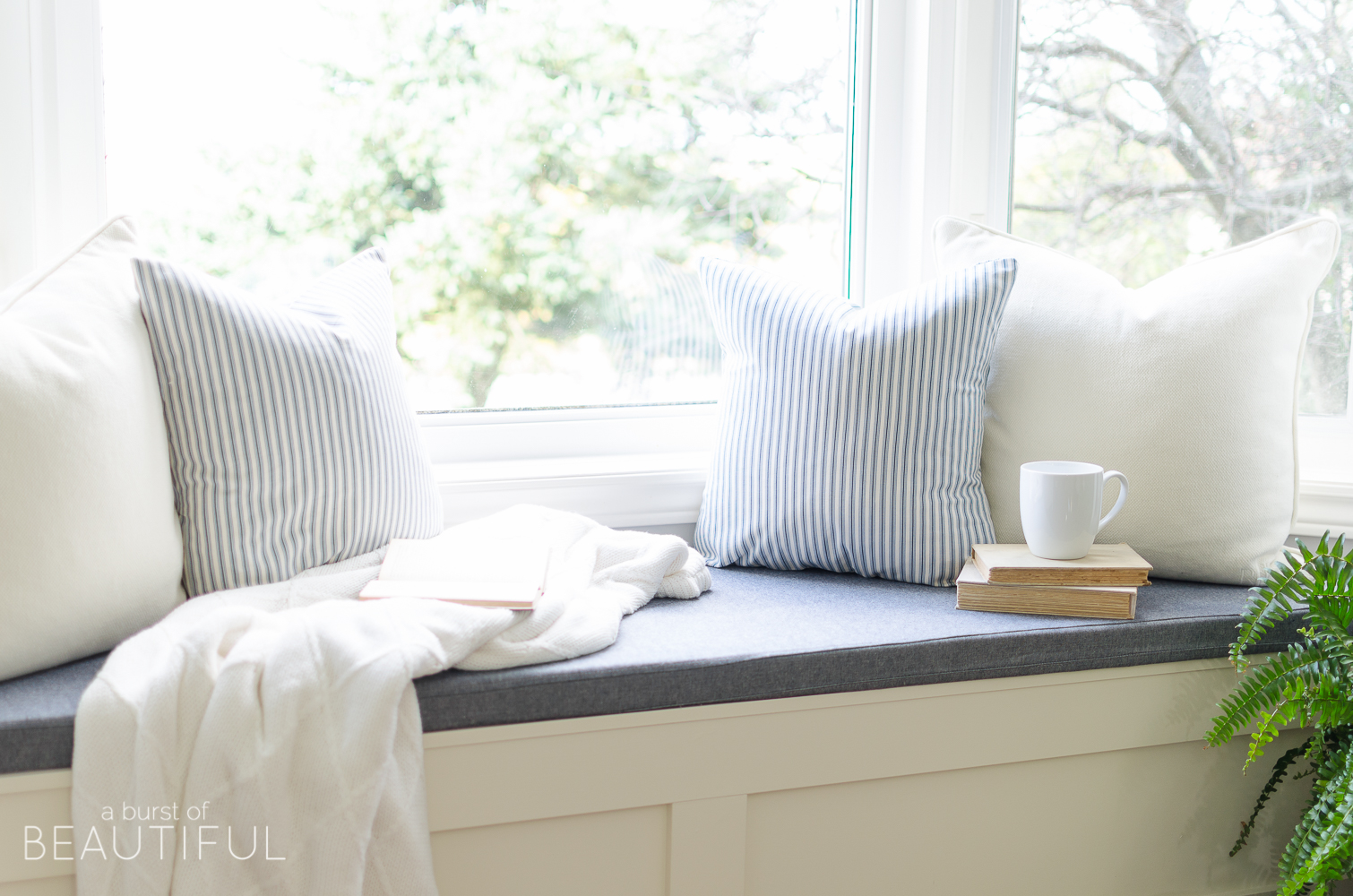
I had considered creating a shelf-like base of operations inside the demote so that when it was open, information technology would look completely finished. All the same, I realized that this would reduce the amount of storage space inside the bench. This won't be something we need to access every day and so it doesn't need to look 'pretty'.
Materials
- 2″ 10 iv″ x 8′ SPF Dimensional Lumber (for framing)
- 1″ x 4″ x viii′ MDF (for the front edge, back border and panel trim)
- 1/4″ten 2′ x 4′ Birch Plywood Handy Panel (nosotros used two for front panels)
- MDF Bullnosed White Shelving v/8 Inch 10 fifteen-1/4 Inch x 96 Inch (for the summit)
- 24 Inch x 1 1/4″ Nickel Continuous Hinge (Piano Hinge)
- Primed Finger-Jointed Pine Cove Trim (for the last step, #xix, if required)
- 2 1/ii″ Kreg Pocket Hole Screws
- 2 1/two″ wood screws
- 2 ane/2″ structure screws
- Wood mucilage
- Wood filler
- one.25″ Brad Nails
- White Caulking
Tools
- Kreg Jig
- Mitre saw
- Round saw
- Cordless Drill
- Brad Nailer
- Caulking Gun
Instructions
- Start and foremost, wear proper personal safety equipment when using any power tools.
- Remove whatever baseboard from the bay window.
- Determine the superlative of your demote. If you are adding a cushion you'll want to reduce the frame height by 2″ plus the tiptop of your seat board. We settled on a finished summit of xx″ including the cushion. Therefore, the math to figure out the height of the frame is 20″ – v/8″ – ii″ = 17 3/eight″.
- Mark the top of the frame at several points along the walls. So utilise a level to draw a line around all three walls of the bay window. You may non hitting the marks you've drawn, just it could be that your floor isn't level. That's ok considering the goal is to brand the top as level as possible.
- Using a stud finder, locate all of the studs in the bay window and mark them above the line y'all've just drawn.
- Mensurate and cut a piece for the center wall with the proper angles to friction match the wall on either finish. For example, if your wall angle measures 135°, then each stop should be cut at 45° (total of 180°). Screw into the studs using 2.5″ screws.
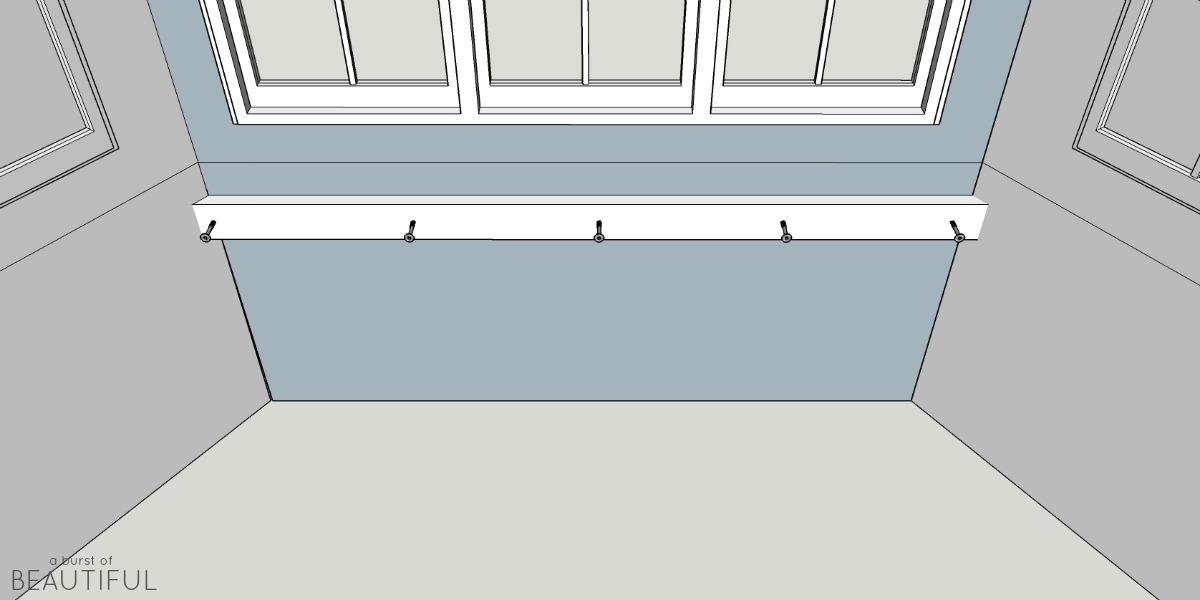
- Then measure out the length from the piece you just installed to the exterior edge of the wall. Deduct two″ for the depth front bridge slice, 1/4″ for the plywood face up and 5/8″ for the trim you will be attaching later. Cut each terminate using the aforementioned angle you used in the previous step, simply they will both be cutting in the same direction equally shown in the diagram beneath.
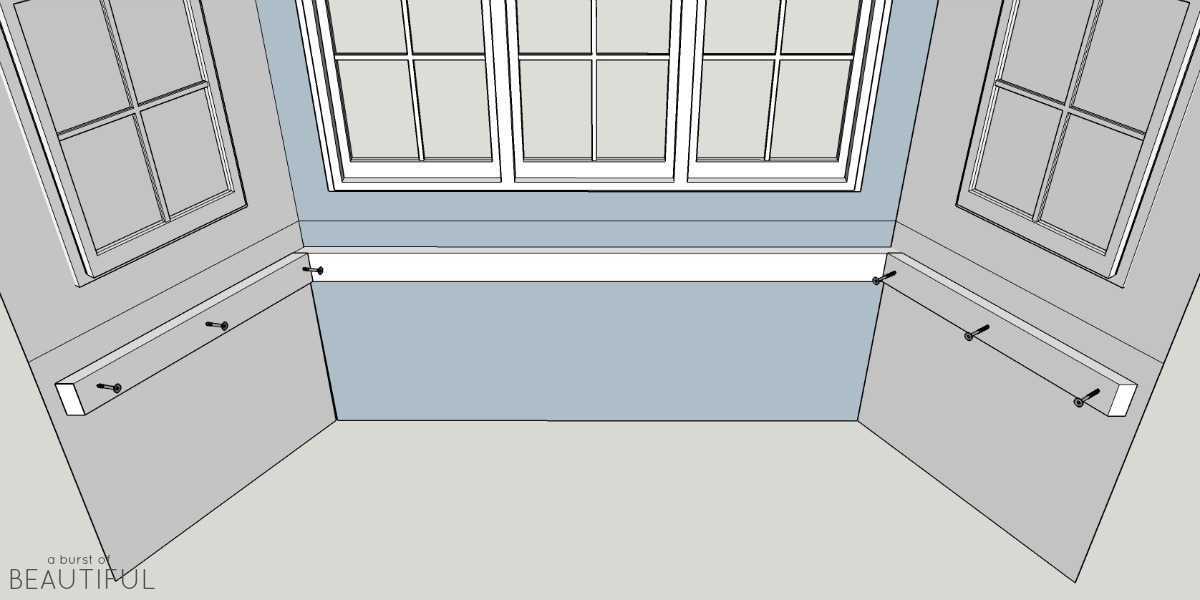
- Measure out and cut two 2″ 10 4″s to fit in the corners for added support at the back. Spiral into studs using two.5″ screws.
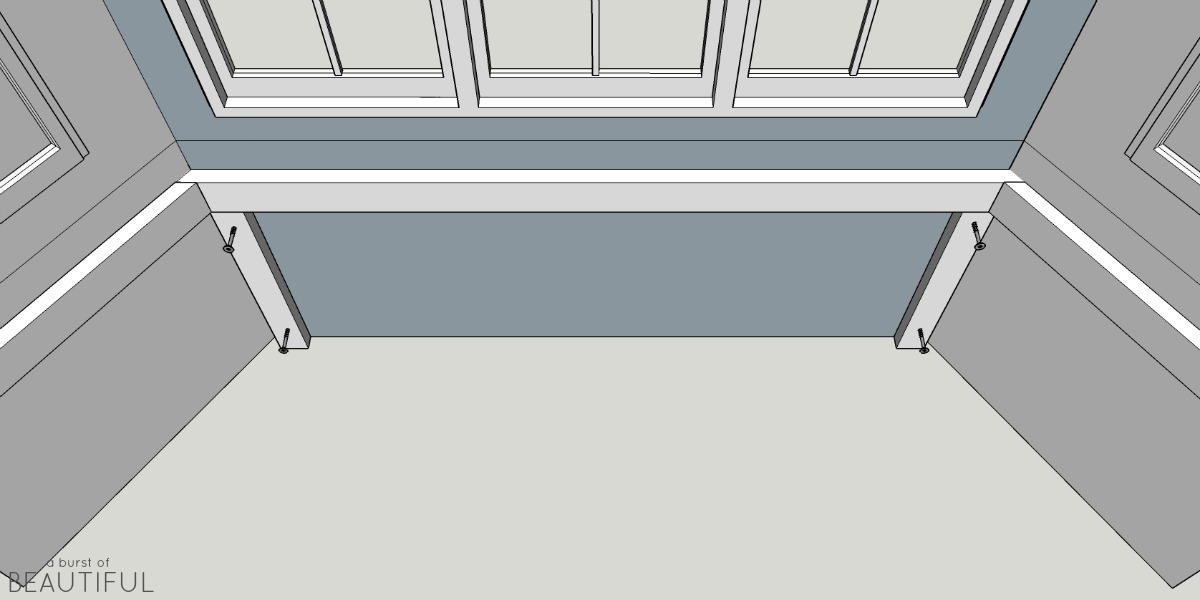
- Measure from one cease to the other and cutting a 2″ x 4″ to length for the front bridge. You tin add together angled ends to match the wall, however, I just left ours at xc°. Attach to the side supports using 2.5″ screws.

- Measure out from the bottom of each side of the front span to the flooring and cut two 2″ x 4″s to these measurements. Drill 2 pocket holes on one end of each. If you lot don't have a Kreg Pocket Pigsty System from The Home Depot (which we couldn't live without now that we take i) you tin simply toenail the screws instead of using pocket holes. Secure to the bottom of the forepart span using 2.5″ pocket hole screws. Then, measure the length forth the flooring between the ii end pieces. Cut a 2″ x 4″ to length and drill two pocket holes on each end. Secure to the end pieces using 2.5″ hole screws.

- Detect and mark the mid-bespeak of the front spans. Measure the altitude between the summit and bottom and cutting a 2″ x 4″ to that size. Drill 2 pocket holes on each end of the board. Secure in place with ii.5″ pocket hole screws. Then find and mark the mid-indicate between the center piece yous just attached and each side of the bench. Measure, cutting, drill and attach these pieces the same way you did the center piece.
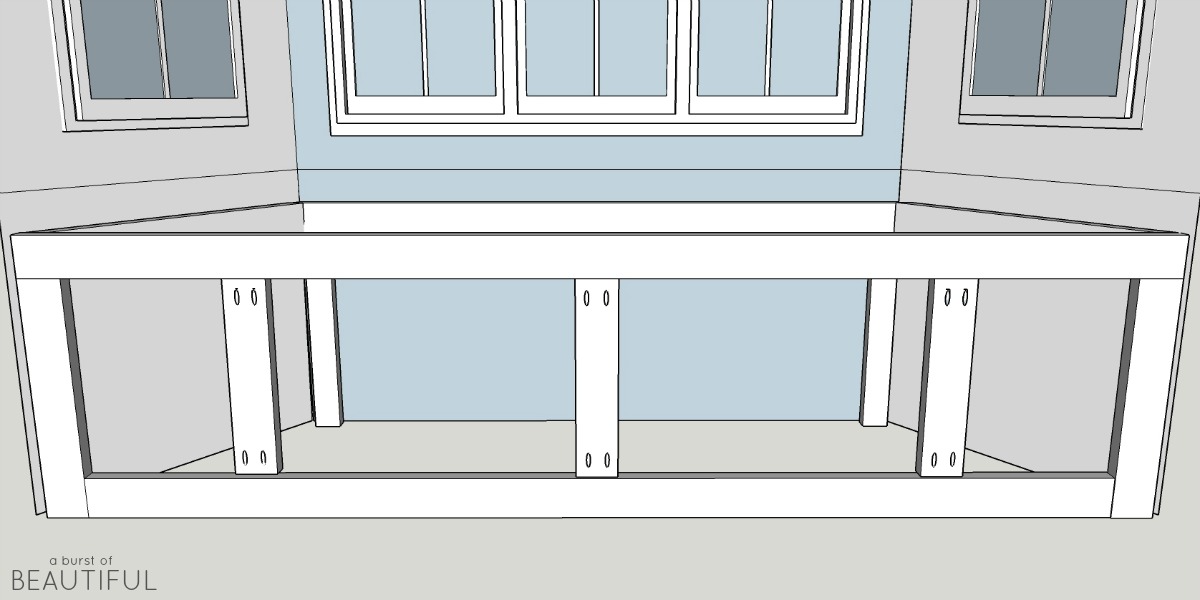
- Measure from the back corners to the top front span. Cutting two pieces of 2″ 10 4″ to fit and drill two pocket holes on one end. Insert and square them up as shown below and utilise ii.5″ pocket hole screws to secure the back and drill through the front span with 2.5″ construction screws to secure in identify.
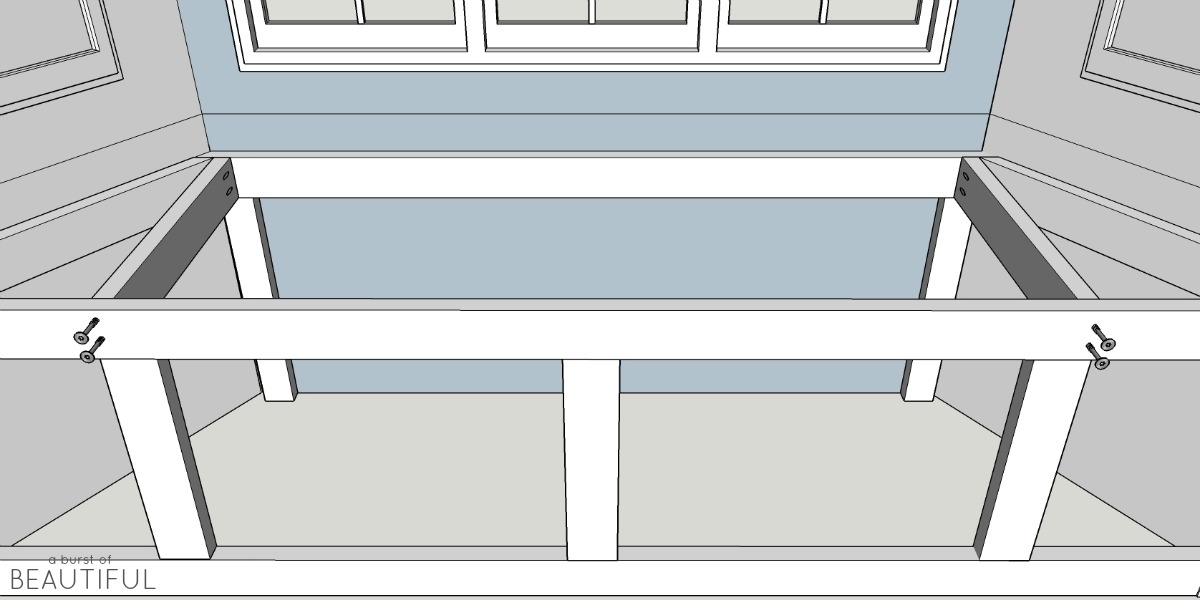
- Measure betwixt the two pieces you just installed. Cut a 2″ x iv″ to size and secure to the dorsum of the frame with 2.five″ construction screws.
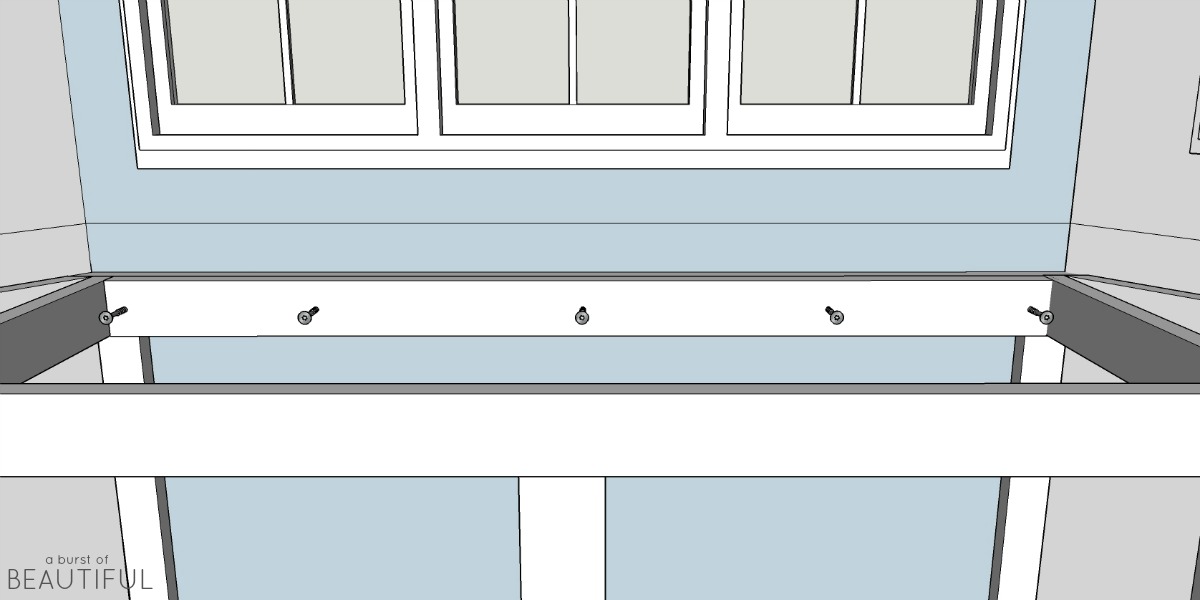
- Cut a 2″ x iv″ to fit the front end area between the side supports. If your bench is square it volition probable be the same length as the board you installed in the terminal step, only mensurate again just to make certain. Secure information technology with the 2″ side against the front end bridge with 2.5″ constructions screws. Then measure out for the pieces that run front to back on each side. Drill pocket holes on one end of each board and spiral in place using four pocket hole screws and three structure screws along each side as per the diagram beneath.
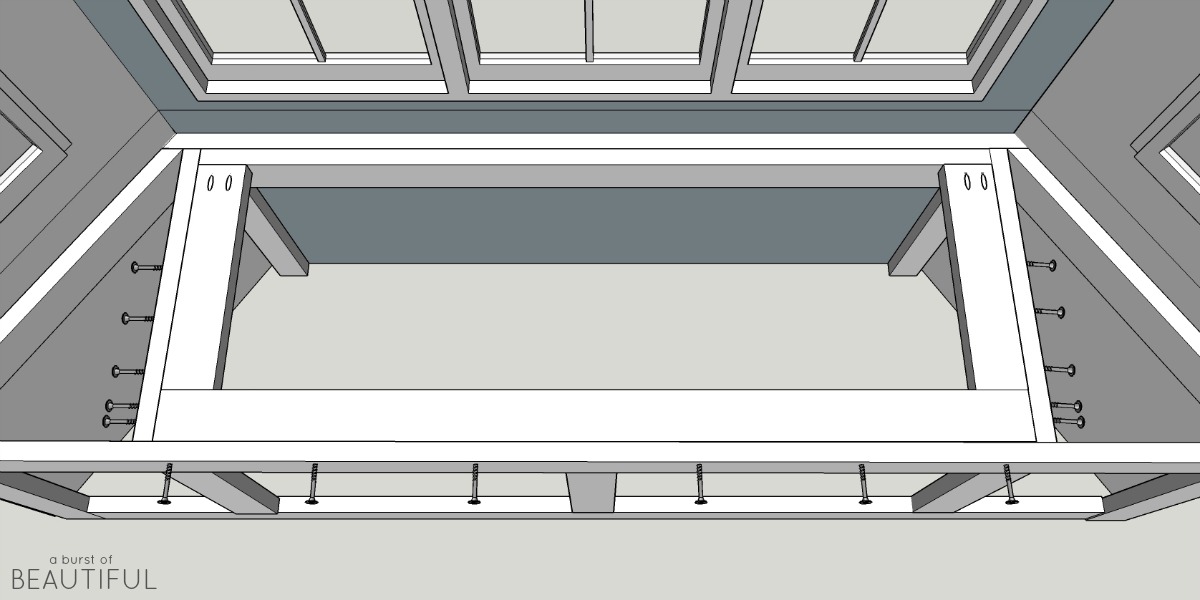
- Cut the 24″ x 48″ 10 1/four″ plywood sheets downwards to size. Nosotros used two panels and joined them in the center where they will be covered with trim, but you tin can buy a single iv′ 10 eight′ 10 1/4″ sheet and cut it downwards to fit if you prefer (24″ x 48″ sheets fit better in a car). Using an air compressor and brad nailer, secure the panels to the front end frame using one i/4″ brad nails. Nail in places that will be covered by the final trim then that you don't have to fill up as many holes.
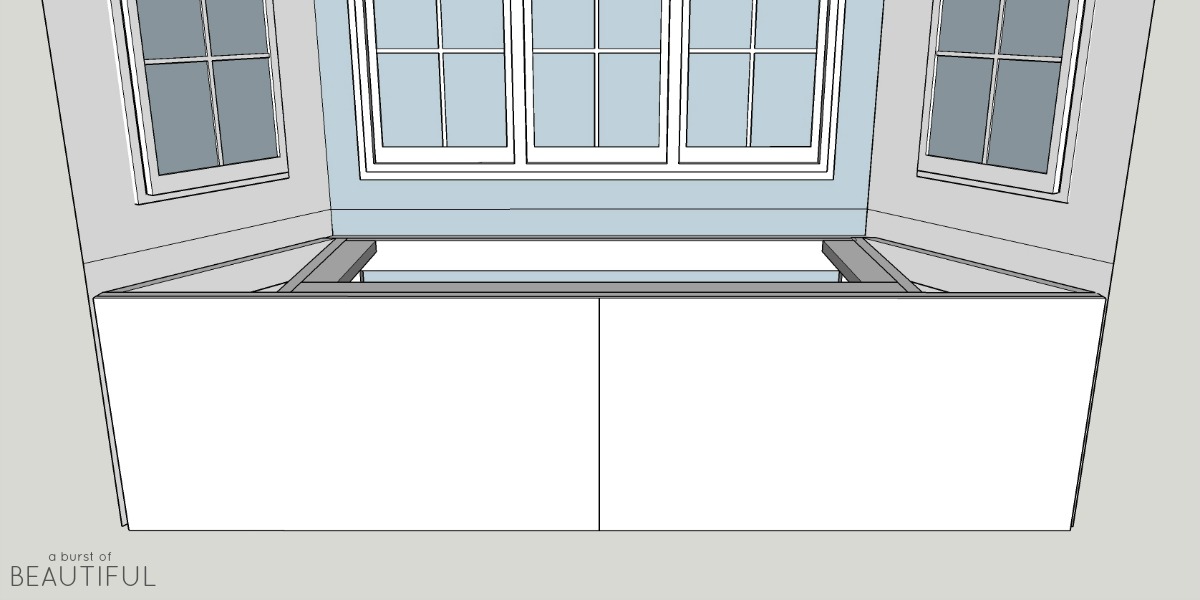
- If yous are going to attach baseboard trim to the bottom of your bench, you will need to bump information technology out by 5/8″. Cut a piece of scrap 5/viii″ plywood to the height and length of your baseboard and attach them to each other with brad nails and mucilage. Then add together a ane″ ten 4″ MDF board on pinnacle of it, and some other 1 at the top of the bench using glue and brad nailer with ane 1/4″ nails.
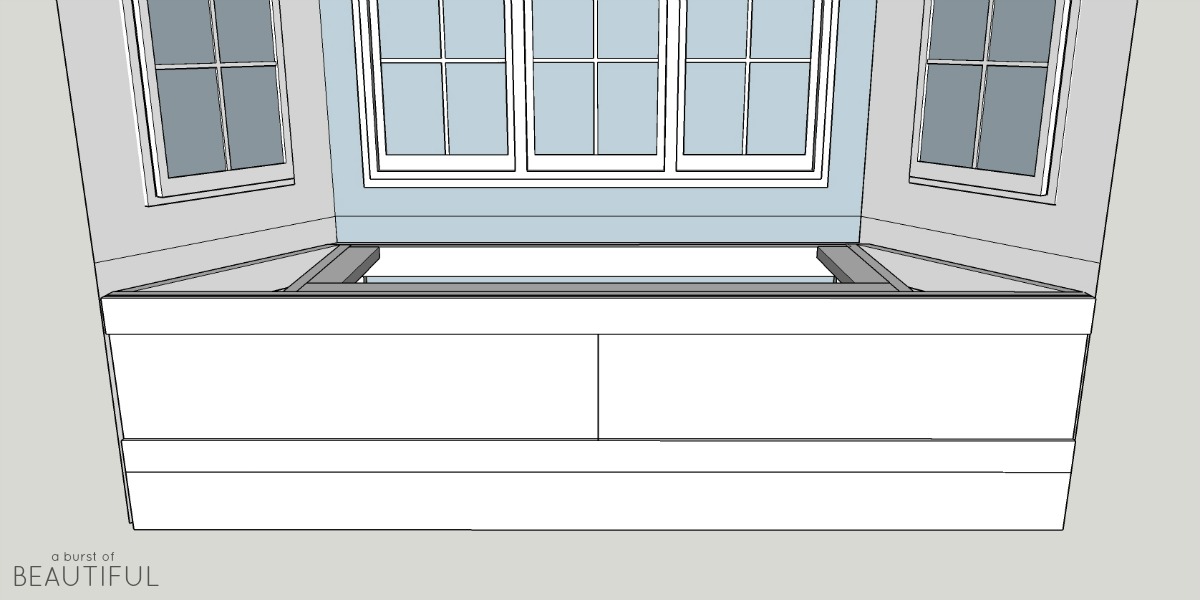
- Add the baseboard dorsum to the bottom, so cut three one″ x iv″ boards for each side and the center to cover the seam of the plywood. Use brad nails and to secure them to the forepart. NOTE: If your bench is really wide, you can also divide the two boxes to brand a total of iv. Only cutting ii more than one″ x iv″south down to size and center them in each of the boxes.

- There are two ways to complete this side by side step. If y'all do not desire to use the bench for storage, you lot tin can just cut a single piece of five/8″ plywood to fit the seating area and add together a piece of decorative 5/8″ trim to the face edge to terminate the look. Or, you can add hidden storage as we did. This part will be a bit of a jigsaw puzzle. The fashion we did it was to first attach the front end lip piece to ensure that the front was square. This front lip made it possible to hide the seams of the lid. It'due south a 1″ x 4″ MPF piece that we made overhang the front by 1/two″. We added angles on the border of this piece to match the angle of the wall to give it more of a finished await. Secure information technology with glue and brad nails. We so cut the sides of the seat out of the MDF shelf board. There are a couple of means to do this. You lot could trace a template on a large piece of paper and then transfer it to the wood. The other method is to mensurate the length from the wall to where the side supports are located at the front end border (along the inside of the front lip slice). You don't want to cover all of the side supports, merely about one-half of it. The other half volition support the hat when it is airtight. You can also use an angle finder (or if yous don't have 1, attach ii 2″ 10 iv″s at i end with 1 spiral so that yous tin can open information technology up like a big angle finder). Place i lath along the front lip piece, and rotate the other to friction match the angle of the wall. Hold the angle of the 2″ ten four″s and transfer to your wood. Cut it out carefully using a circular saw. Cut a slice of plywood or MDF using a jigsaw for the back piece that runs confronting the wall. The goal is to create an absolute square pigsty for the lid to fit in. If your back wall isn't straight or the top is not exactly square, then this is where you lot will make adjustments. You'll also desire to make sure that some of the supporting 2″ x 4″ will even so be visible so it can shoulder some of the seat weight.

- Install the pianoforte hinge to the front of the back 5/viii″ piece you only installed with the hinge facing upward. Be conscientious to adhere it in the right orientation so that your lid swings upwards. Measure out the opening for the lid. Reduce each side by 1/8″ to requite it some clearance. Cut the chapeau out of your shelf board or plywood. On the face side of the lid, drill a 7/8″ pigsty in the centre about 2″ from the front end edge. This will be how you will elevator the storage lid. Make sure you exercise this before y'all test the fit of the lid, or else yous'll have a hard time removing information technology again. In one case you've tested it for fit y'all'll want to have someone help you hold the hat up on an bending so that you can attach the hinge to the back edge of the chapeau.
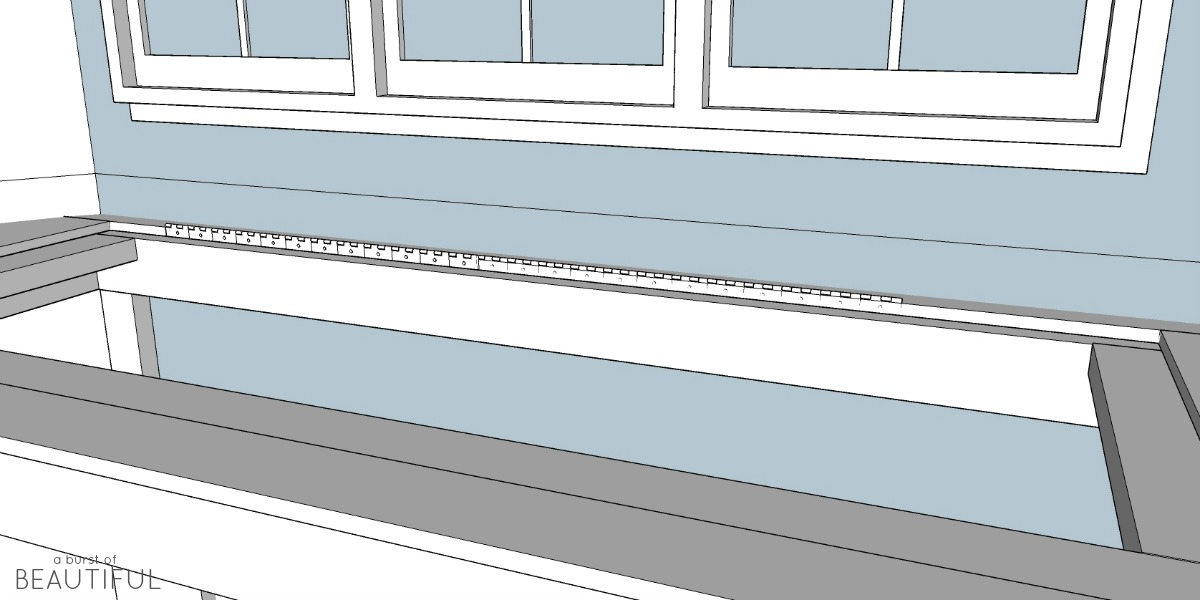
- Caulk around all seams and edges, except for the lid. Fill the brad nail holes with wood filler. Allow to dry and then paint with your trim color. If you have larger than normal gaps around the wall, you can utilize embrace trim similar we did to cover the spaces and requite it a more finished wait.
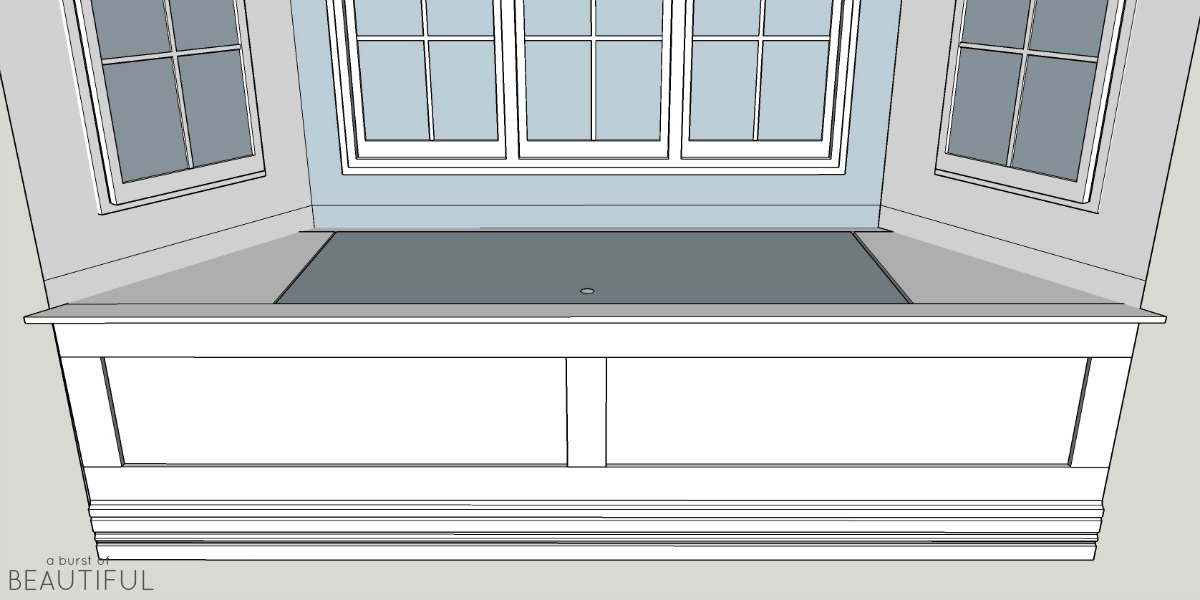
- Discover someone to brand you lot a cushion! We didn't even attempt this on our own. We had a local upholsterer brand united states one for under $200! These can get quite expensive so make certain yous shop around.
Well, that was a lot of explaining! If you lot determine to tackle this project in your house and you lot have whatever questions, we would be happy to effort and help you lot out! Merely ship u.s. your questions and comments beneath. And nosotros'd as well love to meet how yours turns out!
Nick
How To Build A Window Seat Bench,
Source: https://www.nickandalicia.com/2016/10/diy-window-bench-storage.html/
Posted by: romeroforer1992.blogspot.com


0 Response to "How To Build A Window Seat Bench"
Post a Comment